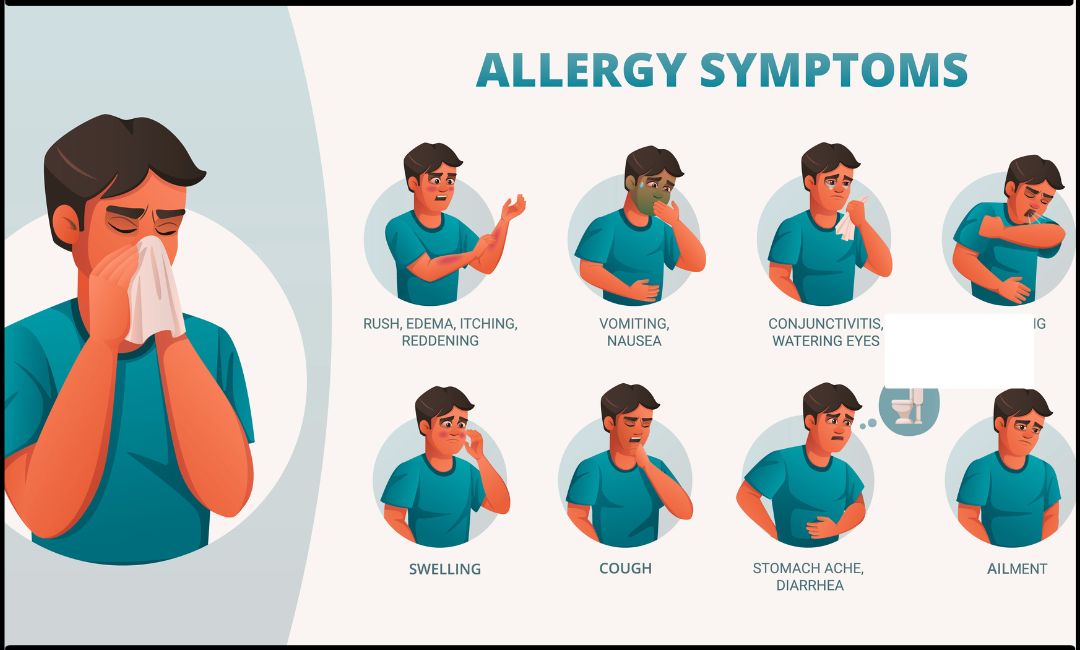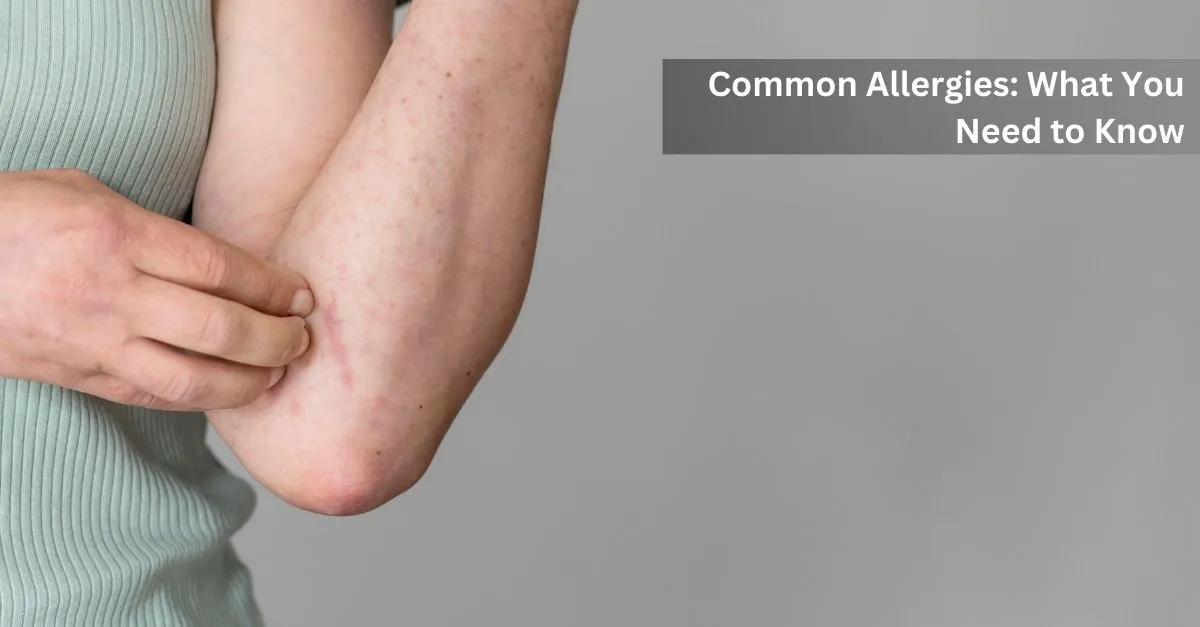Allergies are a prevalent and often troublesome health concern that affect millions of people worldwide. An allergy is an overreaction of the body's immune system to a substance that is typically harmless, such as pollen or certain foods. This immune response can lead to a wide range of symptoms, from mild discomfort to severe reactions. In this comprehensive guide, we will explore various types of allergies, their causes, symptoms, and treatment options, providing you with the knowledge you need to better understand and manage allergies.
Types of Allergies
Allergies can manifest in various ways, affecting different systems and organs in the body. The most common types of allergies include:
Seasonal Allergies (Allergic Rhinitis): Seasonal allergies are triggered by pollen from trees, grasses, and weeds. When inhaled, this pollen can cause symptoms such as sneezing, runny or stuffy nose, itchy or watery eyes, and throat irritation. Seasonal allergies are more prevalent during spring and fall when various plants release pollen.
Food Allergies: Food allergies can cause a wide range of symptoms, from mild hives or an upset stomach to severe anaphylactic reactions. Common food allergens include peanuts, tree nuts, shellfish, eggs, milk, soy, and wheat. Reactions to these allergens can occur within minutes or hours of consuming the problematic food.
Insect Sting Allergies: Some individuals may develop allergies to insect stings from bees, wasps, hornets, and ants. In severe cases, an insect sting can lead to a life-threatening anaphylactic reaction characterized by difficulty breathing, swelling, and a drop in blood pressure.
Contact Dermatitis: This type of allergy is a skin reaction caused by direct contact with an allergen. Common irritants include poison ivy, latex, certain metals (e.g., nickel), and fragrances. Symptoms may include redness, itching, and a rash at the contact site.
Allergic Asthma: Allergies can trigger or exacerbate asthma symptoms. When individuals with allergic asthma come into contact with allergens like pollen, pet dander, or dust mites, they may experience wheezing, coughing, shortness of breath, and chest tightness.
Eczema (Atopic Dermatitis): Eczema is a chronic skin condition characterized by red, itchy rashes. Allergens such as dust mites, pet dander, and certain foods can exacerbate eczema symptoms in some individuals.
Causes of Allergies
Allergies develop when the immune system mistakes a harmless substance, or allergen, for a threat and produces an immune response. The exact cause of why some people develop allergies while others do not is still not entirely understood. However, several factors can contribute to the development of allergies, including:
Genetics: A family history of allergies can increase an individual's risk of developing allergies. If one or both parents have allergies, their children are more likely to develop them as well.
Environmental Factors: Exposure to allergens at a young age may increase the risk of developing allergies. Living in environments with high levels of allergens, such as pollen or dust mites, can contribute to the development of allergic reactions.
Hygiene Hypothesis: This theory suggests that reduced early childhood exposure to germs and infections due to improved hygiene and sanitation can increase the likelihood of developing allergies. The immune system may overreact to allergens in the absence of other challenges.
Dietary Factors: Early introduction of certain foods to an infant's diet, such as peanuts, may either increase or decrease the risk of developing food allergies. The relationship between diet and allergies is complex and not fully understood.
Immune System Dysfunction: Some individuals may have immune systems that are predisposed to overreacting to harmless substances. This heightened immune response can lead to the development of allergies.
Symptoms of Allergies
The symptoms of allergies can vary widely depending on the type of allergen and the individual's sensitivity. Common allergic symptoms include:
• Sneezing
• Runny or stuffy nose
• Itchy or watery eyes
• Coughing
• Wheezing
• Shortness of breath
• Skin rashes or hives
• Swelling of the face, lips, or tongue
• Stomach cramps and diarrhea
• Anaphylaxis (a severe, life-threatening reaction characterized by difficulty breathing, swelling, and a drop in blood pressure)
It's essential to note that the severity of allergic reactions can range from mild to severe. Some allergies, like food allergies, can lead to severe or even fatal outcomes if not managed promptly and appropriately.

Diagnosis of Allergies
If you suspect that you have an allergy, it's important to seek a proper diagnosis from a healthcare professional. Diagnosing allergies typically involves:
Medical History: Your doctor will ask about your symptoms, their frequency, and potential triggers. A detailed medical history can provide valuable insights into the cause of your symptoms.
Physical Examination: A physical examination can help identify visible signs of allergies, such as skin rashes or nasal congestion.
Allergy Testing: There are various methods for allergy testing, including skin prick tests and blood tests. Skin prick tests involve exposing the skin to small amounts of common allergens to observe if a reaction occurs. Blood tests, such as the IgE blood test, measure the level of specific antibodies in the blood associated with allergic reactions.
Elimination Diet: For suspected food allergies, an elimination diet may be recommended. This involves removing potentially allergenic foods from your diet and gradually reintroducing them while monitoring for reactions.
Challenge Testing: In some cases, particularly with suspected food allergies, a challenge test may be performed under medical supervision. This involves consuming the suspected allergen in a controlled setting to assess the body's reaction.
Treatment of Allergies
The most effective way to manage allergies is to avoid exposure to allergens. However, this is not always practical, especially in the case of seasonal allergies or unavoidable allergens like dust mites. Depending on the type and severity of allergies, treatment options may include:
Allergen Avoidance: This is the first line of defense against allergies. Measures may include using air purifiers, keeping windows closed during high pollen seasons, and implementing a dust mite-proof mattress and pillow covers.
Medications: Allergy medications are available both over-the-counter and by prescription. They can provide relief from a wide range of allergy symptoms, including antihistamines, decongestants, and nasal corticosteroids.
Immunotherapy (Allergy Shots): Immunotherapy involves receiving injections of gradually increasing amounts of the allergen. This helps desensitize the immune system, reducing the severity of allergic reactions over time.
Oral Immunotherapy: For certain food allergies, oral immunotherapy may be recommended. This involves consuming small, controlled amounts of the allergenic food to build tolerance over time.
Emergency Epinephrine: Individuals with severe allergies, such as those to insect stings or certain foods, may need to carry an epinephrine auto-injector to be used in case of an anaphylactic reaction.
Topical Creams: For skin allergies, topical corticosteroid creams may provide relief from itching and inflammation.
Preventing Allergies
While it may not always be possible to prevent the development of allergies, there are steps you can take to reduce your risk and manage symptoms:
Minimize Exposure: Take steps to reduce your exposure to known allergens, such as pollen, dust mites, or specific foods.
Monitor Allergen Levels: Stay informed about pollen counts and other environmental factors that may trigger allergies. This information can help you plan your outdoor activities accordingly.
Keep a Clean Home: Regularly clean your home to reduce the presence of dust, mold, and pet dander. Use allergen-proof covers on pillows and mattresses.
Follow Medical Advice: If you have known allergies, adhere to your healthcare provider's recommended treatment plan, including taking prescribed medications as directed.
Educate Yourself: Learn about the specific allergens that trigger your symptoms and take precautions accordingly. This includes reading food labels for allergen information.
Seek Professional Guidance: If you suspect you have allergies, consult with an allergist or immunologist for proper diagnosis and treatment recommendations.
Conclusion
Allergies are a common and often challenging health issue that affects people of all ages. They can manifest in various forms, from seasonal allergies and food allergies to insect stings and skin irritations. While the exact causes of allergies remain complex, genetics, environmental factors, and immune system dysfunction all play a role in their development.
Proper diagnosis is crucial for managing allergies effectively. Depending on the type and severity of allergies, treatment options range from allergen avoidance and medications to immunotherapy and emergency epinephrine.
By understanding the types of allergies, their causes, symptoms, and treatment options, individuals can take proactive steps to minimize their risk, manage their allergies, and lead healthier, more comfortable lives. If you suspect you have allergies, seeking guidance from a healthcare professional is essential for an accurate diagnosis and tailored treatment plan.
.webp)














